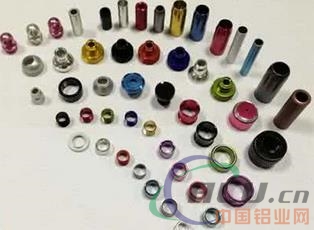
[China Aluminum Network] The surface of the aluminum oxide film is composed of a porous layer, which has a large specific surface area and high chemical activity. Utilizing this feature, a variety of coloring treatments can be performed on the surface of the anodized film, in addition to improving the decorative and corrosion resistance of the product, and also providing various functionalities to the surface of the aluminum product.
There are roughly three types of anodized film coloring methods.
The former class: chemical impregnation
Interior decoration and crafts generally use chemical impregnation
The second type: electrolytic coloring
Aluminum doors and windows generally use electrolytic coloring
The third category: overall coloring
The overall coloring method was used at an early stage, but due to limited color types and relatively high costs, the technology has not been adopted at home and abroad.
Anodizing of aluminum is now taken as an example to describe how to solve the problem of color aberration caused by anodization. First understand the process.
Technology
1, pre-treatment
Degreasing → Alkali washing → Pickling → Polishing
The pre-treatment includes degreasing, caustic washing, polishing, etc. The purpose is to make the surface smooth and glossy, and to remove surface impurities to make it easier to oxidize and color.
Degreasing removes grease from the surface of the metal shell by the action of immersing, separating, emulsifying and saponifying the degreasing agent. By degreasing, oil on the surface of the parts can be removed, so that the following alkaline wash, oxidation and so on.
Alkali washing removes excess grease by the saponification of caustic soda (NaOH) and removes the natural oxide film, burrs, and impurities from the cell phone's metal casing. Reacts with aluminum to remove surface dirt and remove the natural oxide film. The purpose is to activate the surface, and also to remove the extrusion streak and obtain the effect of different reflective surfaces.
Pickling is the removal of dirt on the surface after alkali etching to obtain a cleaner surface. Simultaneously neutralizes the effect of residual alkaline solution on the surface of aluminum parts.
There are two kinds of polishing, one is electrolytic polishing and the other is chemical polishing. Electropolishing is the use of electric current, so that the electrochemical reaction of aluminum alloy occurs in the uneven part of the surface of the aluminum alloy occurs in different degrees of deep solution, so that the aluminum surface produces a smooth mirror effect. Electrolytically polished aluminum parts retain most of their gloss after subsequent anodizing. The higher the purity of the aluminum sheet, the higher the reflectance obtained; the chemical polishing is the chemical ion reaction between aluminum and the chemical polishing solution, and the selective dissolution of the rugged surface of the sample eliminates wear marks, etching and leveling.
2. Anodizing
Anodizing is the process of oxidation on the anode under the action of an applied current to form an oxide film.
3, post-processing
Washing → Coloring → Sealing → Drying
After the washing is performed after the anodization, the sulfuric acid solution remains in the film pores of the oxide film. Therefore, the aluminum product must be thoroughly cleaned before dyeing. Avoid to cause impurity ions in the dyeing tank, especially phosphate ions, fluoride ions, etc., establish pure water cleaning before the dyeing tank, and monitor the water quality.
Coloring is the use of chemical impregnation, which is generally considered to involve both physical adsorption and complexation of organic dye functional groups with alumina.
Sealing treatment is an indispensable part of anodizing. After oxidation dyeing, only the sealing treatment can ensure the original color of the dyed film. There are many methods for sealing the hole. Vapor sealing, hot water sealing, and medium temperature sealing are all good choices. Some dyes can also be cold-sealed. The surface of the oxide film is porous, and dyes can be adsorbed in these pores, and crystal water can also be adsorbed. Due to strong adsorption, if it is not treated in time, impurities may be adsorbed and contaminated, so the filling treatment must be performed in time to increase the porosity. Membrane strength and other properties. There are many ways to close the treatment, such as boiling water method, high-pressure steam method, impregnated metal salt method and filled with organic matter (oil, synthetic resin).
milling cutter,Indexable Ball Nose End Mill,Corn Teeth End Mills.Diamond Coated Drill Bit
JIANGYIN GOLD STAR INDUSTRY CO.,LTD , https://www.jygoldstarindustry.com